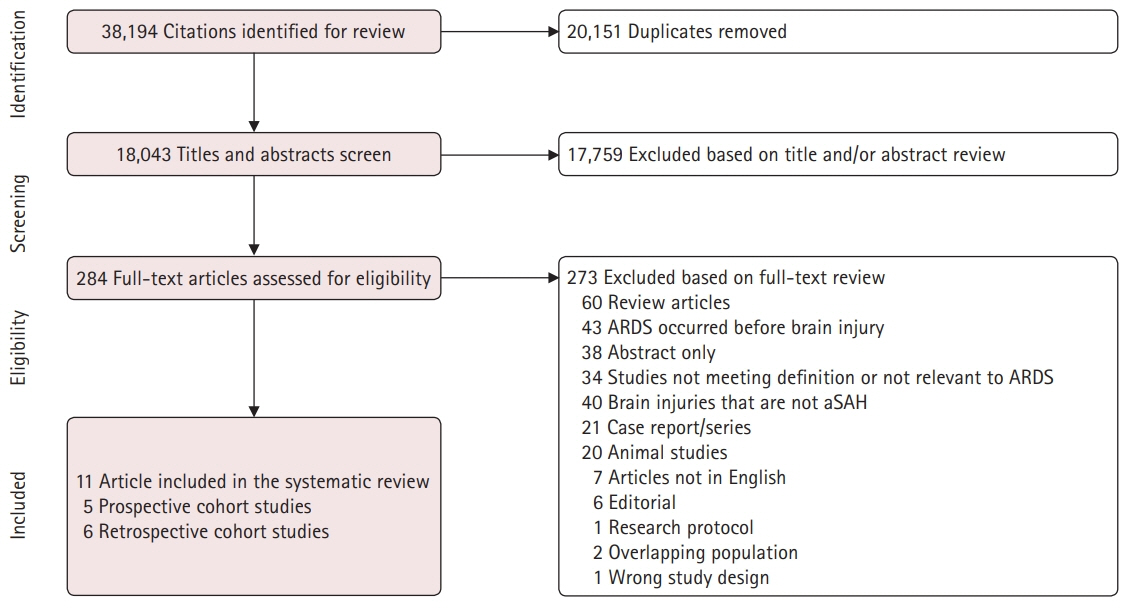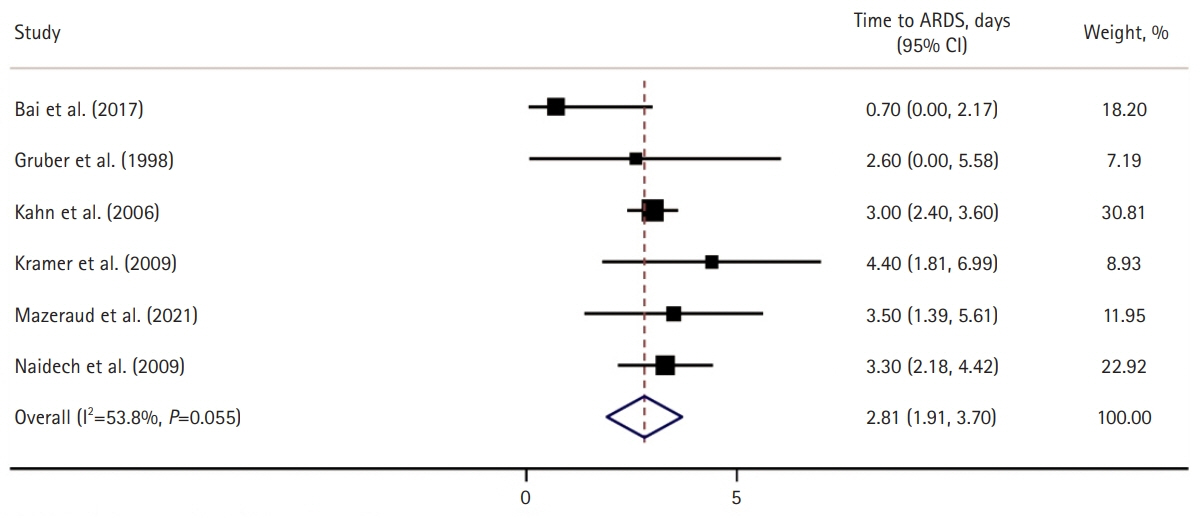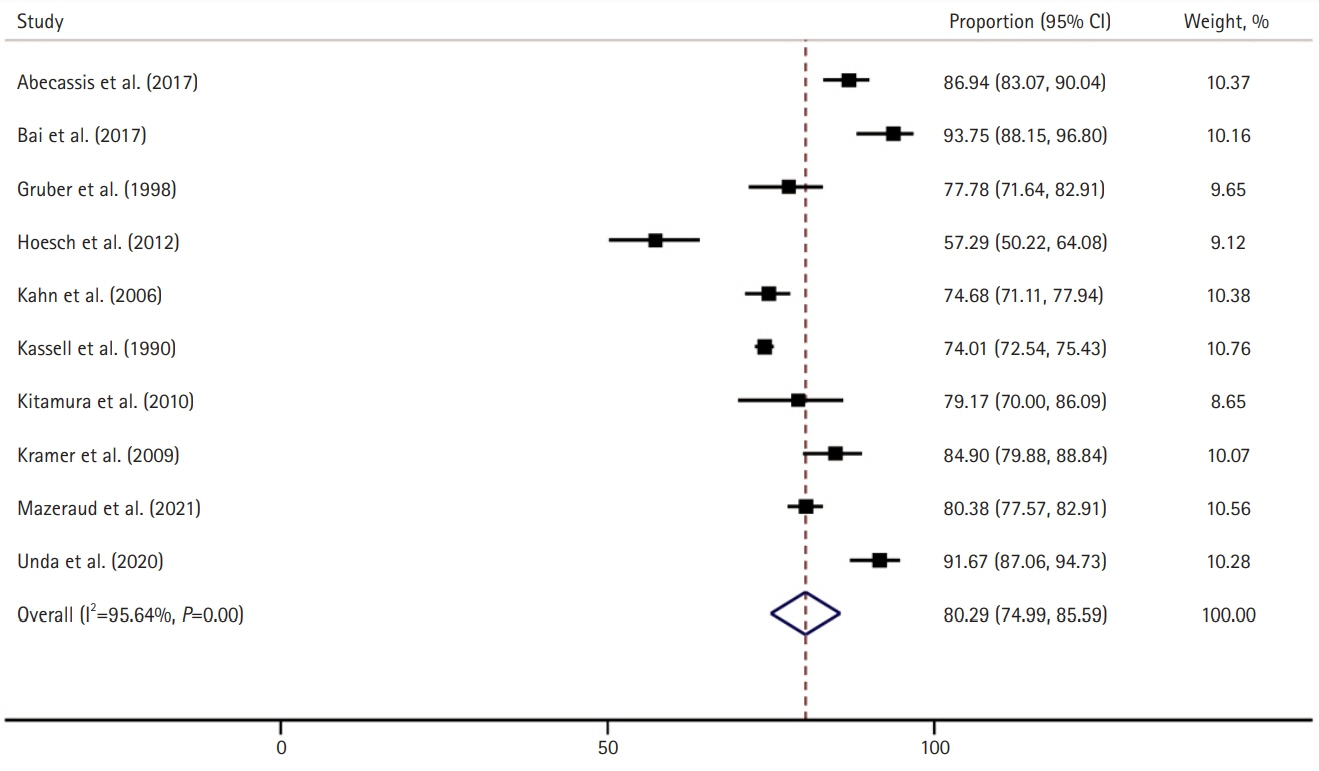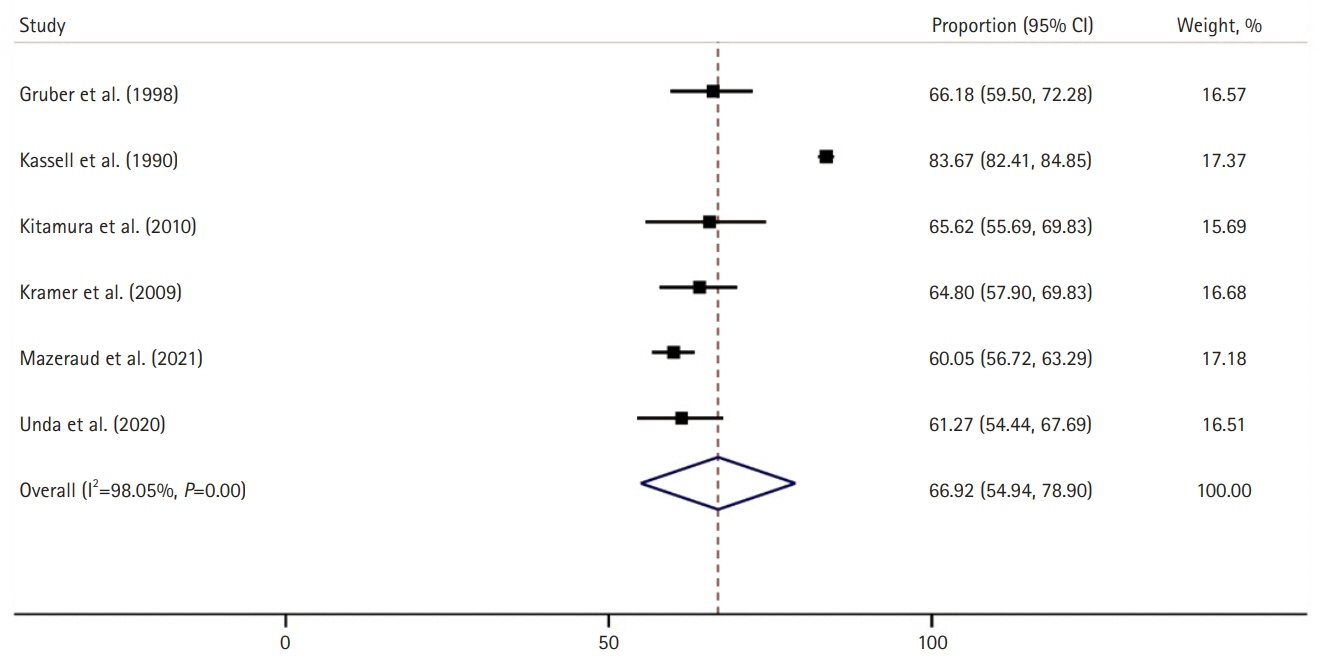J Neurocrit Care.
2022 Jun;15(1):12-20. 10.18700/jnc.220043.
Prevalence and outcomes of acute respiratory distress syndrome in patients with aneurysmal subarachnoid hemorrhage: a systematic review and meta-analysis
- Affiliations
-
- 1Department of Neurology, Massachusetts General Hospital, Harvard Medical School, Boston, MA, USA
- 2Department of Neurology, Cleveland Clinic Foundation, Cleveland, OH, USA
- 3Albert S. Cook Library, Towson University, Towson, MD, USA
- 4Griffith University School of Medicine, Gold Coast, Australia
- 5Department of Neurology,Nneurosurgery, Surgery and Anesth/Critical Care, School of Medicine, Johns Hopkins University, Baltimore, MD, USA
- 6Division of Neuroscience Critical Care, Departments of Neurology, Neurosurgery, Anesthesiology, and Critical Care Medicine, Johns Hopkins University School of Medicine, Baltimore, MD, USA
- KMID: 2531995
- DOI: http://doi.org/10.18700/jnc.220043
Abstract
- Background
In this study, we aimed to investigate the prevalence, timing, risk factors, and outcomes of acute respiratory distress syndrome (ARDS) in patients with aneurysmal subarachnoid hemorrhage (aSAH).
Methods
PubMed and four other databases were searched for randomized controlled trials (RCTs) and observational studies of patients 18 years or older through October 20, 2021. Study quality was assessed, using the Cochrane Risk of Bias tool for RCTs and the Newcastle-Ottawa Scale for cohort and case-control studies. High-grade aSAH was defined as a Hunt-Hess grade≥3 and/or a modified Fisher score≥3. A good neurological outcome was defined as a Glasgow Outcome Scale score ≥4. Random-effects meta-analyses were conducted to estimate the pooled outcome prevalence and 95% confidence interval (CI).
Results
Eleven observational studies (n=6,107) met the inclusion criteria. Overall, 15% of the patients (95% CI=10.5–20.0; I2=97.8%) developed ARDS after aSAH, with a mean time of 3 days (95% CI=1.9–3.7; I2=54%). Overall survival at discharge was 80% (95% CI=75–86; I2=96%), and 67% of aSAH patients (95% CI=54.9–78.9; I2=94%) had a good neurological outcome at any time. The aSAH cohort without ARDS had a higher rate of survival than those with ARDS (79% vs. 49%, P=0.028). Male sex, patients with a high-grade aSAH, patients who developed pneumonia, and systemic inflammatory response syndrome during hospital admission were at a higher risk of developing ARDS.
Conclusion
In this meta-analysis, approximately one in six patients developed ARDS after aSAH, with a mean time of 3 days from the initial presentation, and ARDS was associated with increased mortality.
Keyword
Figure
Reference
-
1. Virani SS, Alonso A, Aparicio HJ, Benjamin EJ, Bittencourt MS, Callaway CW, et al. Heart disease and stroke statistics: 2021 update: a report from the American Heart Association. Circulation. 2021; 143:e254–743.2. Lovelock CE, Rinkel GJ, Rothwell PM. Time trends in outcome of subarachnoid hemorrhage: population-based study and systematic review. Neurology. 2010; 74:1494–501.
Article3. Solenski NJ, Haley EC Jr, Kassell NF, Kongable G, Germanson T, Truskowski L, et al. Medical complications of aneurysmal subarachnoid hemorrhage: a report of the multicenter, cooperative aneurysm study. Crit Care Med. 1995; 23:1007–17.4. Thompson BT, Chambers RC, Liu KD. Acute respiratory distress syndrome. N Engl J Med. 2017; 377:562–72.
Article5. Rogers FB, Shackford SR, Trevisani GT, Davis JW, Mackersie RC, Hoyt DB. Neurogenic pulmonary edema in fatal and nonfatal head injuries. J Trauma. 1995; 39:860–8.
Article6. Muroi C, Keller M, Pangalu A, Fortunati M, Yonekawa Y, Keller E. Neurogenic pulmonary edema in patients with subarachnoid hemorrhage. J Neurosurg Anesthesiol. 2008; 20:188–92.
Article7. Friedman JA, Pichelmann MA, Piepgras DG, McIver JI, Toussaint LG 3rd, McClelland RL, et al. Pulmonary complications of aneurysmal subarachnoid hemorrhage. Neurosurgery. 2003; 52:1025–32.
Article8. Kahn JM, Caldwell EC, Deem S, Newell DW, Heckbert SR, Rubenfeld GD. Acute lung injury in patients with subarachnoid hemorrhage: incidence, risk factors, and outcome. Crit Care Med. 2006; 34:196–202.
Article9. Feigin VL, Lawes CM, Bennett DA, Barker-Collo SL, Parag V. Worldwide stroke incidence and early case fatality reported in 56 population-based studies: a systematic review. Lancet Neurol. 2009; 8:355–69.
Article10. Go AS, Mozaffarian D, Roger VL, Benjamin EJ, Berry JD, Blaha MJ, et al. Executive summary: heart disease and stroke statistics: 2014 update: a report from the American Heart Association. Circulation. 2014; 129:399–410.
Article11. Liberati A, Altman DG, Tetzlaff J, Mulrow C, Gøtzsche PC, Ioannidis JP, et al. The PRISMA statement for reporting systematic reviews and meta-analyses of studies that evaluate health care interventions: explanation and elaboration. J Clin Epidemiol. 2009; 62:e1–34.
Article12. Bernard GR, Artigas A, Brigham KL, Carlet J, Falke K, Hudson L, et al. The American-European Consensus Conference on ARDS: definitions, mechanisms, relevant outcomes, and clinical trial coordination. Am J Respir Crit Care Med. 1994; 149(3 Pt 1):818–24.
Article13. ARDS Definition Task Force, Ranieri VM, Rubenfeld GD, Thompson BT, Ferguson ND, Caldwell E, et al. Acute respiratory distress syndrome: the Berlin definition. JAMA. 2012; 307:2526–33.14. Jennett B, Snoek J, Bond MR, Brooks N. Disability after severe head injury: observations on the use of the Glasgow Outcome Scale. J Neurol Neurosurg Psychiatry. 1981; 44:285–93.
Article15. Wells GA, Shea B, O’Connell D, Peterson J, Welch V, Losos MP. The Newcastle-Ottawa Scale (NOS) for assessing the quality of nonrandomised studies in meta-analyses. Ottawa: Ottawa Hospital Research Institute;2000.16. Sidik K, Jonkman JN. A comparison of heterogeneity variance estimators in combining results of studies. Stat Med. 2007; 26:1964–81.
Article17. IntHout J, Ioannidis JP, Borm GF. The Hartung-Knapp-Sidik-Jonkman method for random effects meta-analysis is straightforward and considerably outperforms the standard DerSimonian-Laird method. BMC Med Res Methodol. 2014; 14:25.
Article18. Higgins JP, Thompson SG. Quantifying heterogeneity in a meta-analysis. Stat Med. 2002; 21:1539–58.
Article19. Abecassis IJ, Morton RP, McGrath L, Hanson J, Xue AH, Kelly CM, et al. Respiratory and swallowing outcomes based on aneurysm location in 360 patients with subarachnoid hemorrhage. World Neurosurg. 2017; 105:108–14.
Article20. Bai W, Li W, Ning YL, Li P, Zhao Y, Yang N, et al. Blood glutamate levels are closely related to acute lung injury and prognosis after stroke. Front Neurol. 2018; 8:755.
Article21. Gruber A, Reinprecht A, Görzer H, Fridrich P, Czech T, Illievich UM, Richling B. Pulmonary function and radiographic abnormalities related to neurological outcome after aneurysmal subarachnoid hemorrhage. J Neurosurg. 1998; 88:28–37.
Article22. Hoesch RE, Lin E, Young M, Gottesman RF, Altaweel L, Nyquist PA, et al. Acute lung injury in critical neurological illness. Crit Care Med. 2012; 40:587–93.
Article23. Kassell NF, Torner JC, Haley EC Jr, Jane JA, Adams HP, Kongable GL. the international cooperative study on the timing of aneurysm surgery. Part 1: overall management results. J Neurosurg. 1990; 73:18–36.24. Kitamura Y, Nomura M, Shima H, Kuwana N, Kuramitsu T, Chang CC, et al. Acute lung injury associated with systemic inflammatory response syndrome following subarachnoid hemorrhage: a survey by the Shonan Neurosurgical Association. Neurol Med Chir (Tokyo). 2010; 50:456–60.
Article25. Kramer AH, Bleck TP, Dumont AS, Kassell NF, Olson C, Nathan B. Implications of early versus late bilateral pulmonary infiltrates in patients with aneurysmal subarachnoid hemorrhage. Neurocrit Care. 2009; 10:20–7.
Article26. Mazeraud A, Robba C, Rebora P, Iaquaniello C, Vargiolu A, Rass V, et al. Acute distress respiratory syndrome after subarachnoid hemorrhage: incidence and impact on the outcome in a large multicenter, retrospective cohort. Neurocrit Care. 2021; 34:1000–8.
Article27. Naidech AM, Bassin SL, Garg RK, Ault ML, Bendok BR, Batjer HH, et al. Cardiac troponin I and acute lung injury after subarachnoid hemorrhage. Neurocrit Care. 2009; 11:177–82.
Article28. Unda SR, Labagnara K, Birnbaum J, Wong M, de Silva N, Terala H, et al. Impact of hospital-acquired complications in long-term clinical outcomes after subarachnoid hemorrhage. Clin Neurol Neurosurg. 2020; 194:105945.
Article29. Wood James H. Cerebral blood flow. In : Carter L Phillip, Spetzler Robert F, Hamilton Mark G, editors. Neurovascular surgery. Ed 1. New York, NY: McGraw-Hill;1995. p. 127–41.30. Stevens RD, Nyquist PA. The systemic implications of aneurysmal subarachnoid hemorrhage. J Neurol Sci. 2007; 261:143–56.
Article31. Sarnoff SJ, Sarnoff LC. Neurohemodynamics of pulmonary edema. II. The role of sympathetic pathways in the elevation of pulmonary and systemic vascular pressures following the intracisternal injection of fibrin. Circulation. 1952; 6:51–62.32. Catapano JS, Ducruet AF, Frisoli FA, Nguyen CL, Louie CE, Labib MA, et al. Predictors of the development of takotsubo cardiomyopathy in aneurysmal subarachnoid hemorrhage and outcomes in patients with intra-aortic balloon pumps. J Neurosurg. 2020; Sep. 4. [Epub]. https://doi.org/10.3171/2020.5.JNS20536.
Article33. Veeravagu A, Chen YR, Ludwig C, Rincon F, Maltenfort M, Jallo J, et al. Acute lung injury in patients with subarachnoid hemorrhage: a nationwide inpatient sample study. World Neurosurg. 2014; 82:e235–41.
Article34. Gruber A, Reinprecht A, Illievich UM, Fitzgerald R, Dietrich W, Czech T, et al. Extracerebral organ dysfunction and neurologic outcome after aneurysmal subarachnoid hemorrhage. Crit Care Med. 1999; 27:505–14.
Article35. Acute Respiratory Distress Syndrome Network, Brower RG, Matthay MA, Morris A, Schoenfeld D, Thompson BT, et al. Ventilation with lower tidal volumes as compared with traditional tidal volumes for acute lung injury and the acute respiratory distress syndrome. N Engl J Med. 2000; 342:1301–8.
Article36. Amato MB, Barbas CS, Medeiros DM, Magaldi RB, Schettino GP, Lorenzi-Filho G, et al. Effect of a protective-ventilation strategy on mortality in the acute respiratory distress syndrome. N Engl J Med. 1998; 338:347–54.
Article37. de Haro C, Martin-Loeches I, Torrents E, Artigas A. Acute respiratory distress syndrome: prevention and early recognition. Ann Intensive Care. 2013; 3:11.
Article38. Caricato A, Conti G, Della Corte F, Mancino A, Santilli F, Sandroni C, et al. Effects of PEEP on the intracranial system of patients with head injury and subarachnoid hemorrhage: the role of respiratory system compliance. J Trauma. 2005; 58:571–6.
Article39. McGuire G, Crossley D, Richards J, Wong D. Effects of varying levels of positive end-expiratory pressure on intracranial pressure and cerebral perfusion pressure. Crit Care Med. 1997; 25:1059–62.
Article40. Muench E, Bauhuf C, Roth H, Horn P, Phillips M, Marquetant N, et al. Effects of positive end-expiratory pressure on regional cerebral blood flow, intracranial pressure, and brain tissue oxygenation. Crit Care Med. 2005; 33:2367–72.
Article41. Nemer SN, Caldeira JB, Azeredo LM, Garcia JM, Silva RT, Prado D, et al. Alveolar recruitment maneuver in patients with subarachnoid hemorrhage and acute respiratory distress syndrome: a comparison of 2 approaches. J Crit Care. 2011; 26:22–7.
Article
- Full Text Links
- Actions
-
Cited
- CITED
-
- Close
- Share
- Similar articles
-
- Hemodynamics of Poor-grade Subarachnoid Hemorrhage
- A Case of Turner Syndrome Presenting as Aneurysmal Subarachnoid Hemorrhage
- Simultaneous Occurrence of Aneurysmal Subarachnoid Hemorrhage and Hypertensive Intracerebral Hemorrhage
- Frequency of Aneurysmal Subarachnoid Hemorrhage in Perimesencephalic Subarachnoid Hemorrhage and Need of 4-vessel Angiography
- Delayed Vasospasm after Aneurysmal Subarachnoid Hemorrhage in Behcet Syndrome






